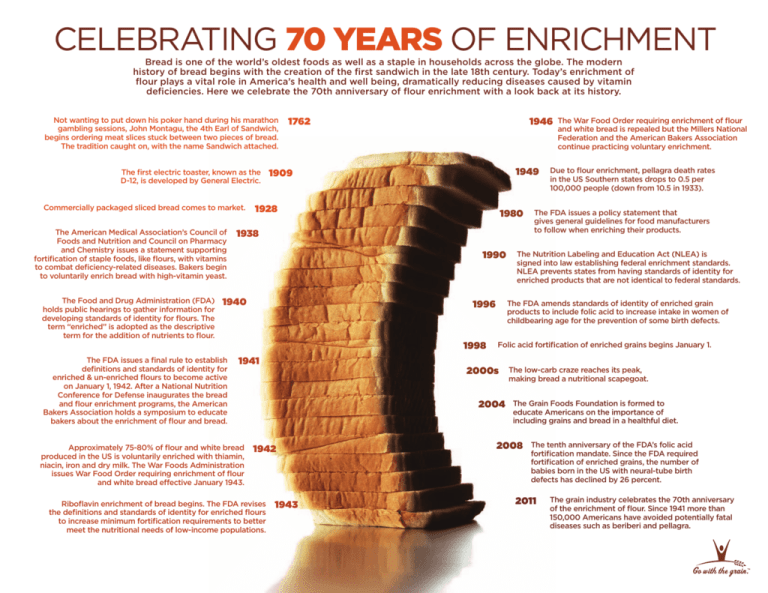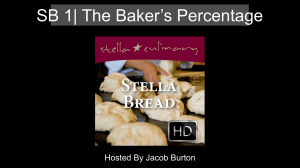CELEBRATING 70 years OF ENRICHMENT
advertisement

Celebrating 70 years of enrichment Bread is one of the world’s oldest foods as well as a staple in households across the globe. The modern history of bread begins with the creation of the first sandwich in the late 18th century. Today’s enrichment of flour plays a vital role in America’s health and well being, dramatically reducing diseases caused by vitamin deficiencies. Here we celebrate the 70th anniversary of flour enrichment with a look back at its history. Not wanting to put down his poker hand during his marathon gambling sessions, John Montagu, the 4th Earl of Sandwich, begins ordering meat slices stuck between two pieces of bread. The tradition caught on, with the name Sandwich attached. The first electric toaster, known as the D-12, is developed by General Electric. Commercially packaged sliced bread comes to market. The American Medical Association’s Council of Foods and Nutrition and Council on Pharmacy and Chemistry issues a statement supporting fortification of staple foods, like flours, with vitamins to combat deficiency-related diseases. Bakers begin to voluntarily enrich bread with high-vitamin yeast. The Food and Drug Administration (FDA) holds public hearings to gather information for developing standards of identity for flours. The term “enriched” is adopted as the descriptive term for the addition of nutrients to flour. 1762 1949 1909 1928 1980 1938 1990 1940 The FDA issues a final rule to establish definitions and standards of identity for enriched & un-enriched flours to become active on January 1, 1942. After a National Nutrition Conference for Defense inaugurates the bread and flour enrichment programs, the American Bakers Association holds a symposium to educate bakers about the enrichment of flour and bread. 1946 1996 1998 1941 Approximately 75-80% of flour and white bread produced in the US is voluntarily enriched with thiamin, niacin, iron and dry milk. The War Foods Administration issues War Food Order requiring enrichment of flour and white bread effective January 1943. 1943 The FDA issues a policy statement that gives general guidelines for food manufacturers to follow when enriching their products. The Nutrition Labeling and Education Act (NLEA) is signed into law establishing federal enrichment standards. NLEA prevents states from having standards of identity for enriched products that are not identical to federal standards. Folic acid fortification of enriched grains begins January 1. 2004 Riboflavin enrichment of bread begins. The FDA revises the definitions and standards of identity for enriched flours to increase minimum fortification requirements to better meet the nutritional needs of low-income populations. Due to flour enrichment, pellagra death rates in the US Southern states drops to 0.5 per 100,000 people (down from 10.5 in 1933). The FDA amends standards of identity of enriched grain products to include folic acid to increase intake in women of childbearing age for the prevention of some birth defects. 2000s 1942 The War Food Order requiring enrichment of flour and white bread is repealed but the Millers National Federation and the American Bakers Association continue practicing voluntary enrichment. The low-carb craze reaches its peak, making bread a nutritional scapegoat. The Grain Foods Foundation is formed to educate Americans on the importance of including grains and bread in a healthful diet. 2008 The tenth anniversary of the FDA’s folic acid fortification mandate. Since the FDA required fortification of enriched grains, the number of babies born in the US with neural-tube birth defects has declined by 26 percent. 2011 The grain industry celebrates the 70th anniversary of the enrichment of flour. Since 1941 more than 150,000 Americans have avoided potentially fatal diseases such as beriberi and pellagra.








